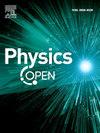晶体四面体和八面体孔洞对铁基尖晶石辐射屏蔽性能的影响
IF 1.4
Q2 Physics and Astronomy
引用次数: 0
摘要
本研究研究了六种铁基尖晶石化合物(Fe3O4, MnFe2O4, NiFe2O4, CoFe2O4, ZnFe2O4和CuFe2O4)作为辐射屏蔽材料的潜在候选材料。利用NIST XCOM在0.015 ~ 15 MeV范围内的光子截面(与Phy-X/PSD交叉检查),评估了关键的屏蔽参数,包括质量衰减系数(MAC)、线性衰减系数(LAC)、半值层(HVL)、十值层(TVL)和平均自由程(MFP)。此外,原子参数,如有效原子序数(Zeff),电子密度(Neff)和等效原子序数(Zeq)进行了评估。衰减指标与密度和晶体描述符——四面体(Vtet)和八面体(Voct)空隙体积和晶格空隙比(R)——以及离子位点分布有关。计算表明,LAC呈下降趋势:ZnFe2O4 >; CuFe2O4 > NiFe2O4 > CoFe2O4 > MnFe2O4 > Fe3O4。密度与LAC呈正相关,同时HVL和TVL值降低。此外,在亚mev能量下,随着vvet /Voct的降低和R的降低,MAC呈现定性的(单调的)增加,与更密集的电子封装一致。在所分析的化合物中,CuFe2O4和ZnFe2O4在衰减能力和材料厚度效率方面表现出最高的屏蔽性能。由于数据集包含六个组成(n = 6),这些结构-属性关系被报告为描述性趋势,而不是拟合相关性。这些发现突出了晶胞内的结晶度和离子分布对辐射屏蔽材料有效性的关键影响,为设计耐用的无铅屏蔽材料提供了可行的目标(更小的Vtet/Voct和更低的R)。本文章由计算机程序翻译,如有差异,请以英文原文为准。
Influence of crystal tetrahedral and octahedral voids on the radiation shielding properties of iron-based spinels
This study investigates six iron-based spinel compounds (Fe3O4, MnFe2O4, NiFe2O4, CoFe2O4, ZnFe2O4, and CuFe2O4) as potential candidates for radiation shielding materials. Using the NIST XCOM photon cross-sections (cross-checked with Phy-X/PSD) across 0.015–15 MeV, key shielding parameters were evaluated, including mass attenuation coefficient (MAC), linear attenuation coefficient (LAC), half-value layer (HVL), tenth-value layer (TVL), and mean free path (MFP). Additionally, atomistic parameters such as the effective atomic number (Zeff), electron density (Neff), and equivalent atomic number (Zeq) were assessed. Attenuation metrics were related to density and crystallographic descriptors—tetrahedral (Vtet) and octahedral (Voct) void volumes and the lattice void ratio (R)—together with ionic site distribution. Calculations show a descending LAC trend as follows: ZnFe2O4 > CuFe2O4 > NiFe2O4 > CoFe2O4 > MnFe2O4 > Fe3O4. A positive correlation between density and LAC was identified, accompanied by a reduction in HVL and TVL values. Furthermore, at sub-MeV energies, MAC shows a qualitative (monotonic) increase with decreasing Vtet/Voct and lower R, consistent with denser electronic packing. Among the compounds analysed, CuFe2O4 and ZnFe2O4 demonstrated the highest shielding performance in attenuation capability and material thickness efficiency. Since the dataset comprises six compositions (n = 6), these structure–property relationships are reported as descriptive trends rather than fitted correlations. These findings highlight the critical influence of crystallinity and ionic distribution within the unit cell on the effectiveness of radiation shielding materials, providing actionable targets (smaller Vtet/Voct and lower R) for designing durable, lead-free shields.
求助全文
通过发布文献求助,成功后即可免费获取论文全文。
去求助
来源期刊

Physics Open
Physics and Astronomy-Physics and Astronomy (all)
CiteScore
3.20
自引率
0.00%
发文量
19
审稿时长
9 weeks
 求助内容:
求助内容: 应助结果提醒方式:
应助结果提醒方式:


